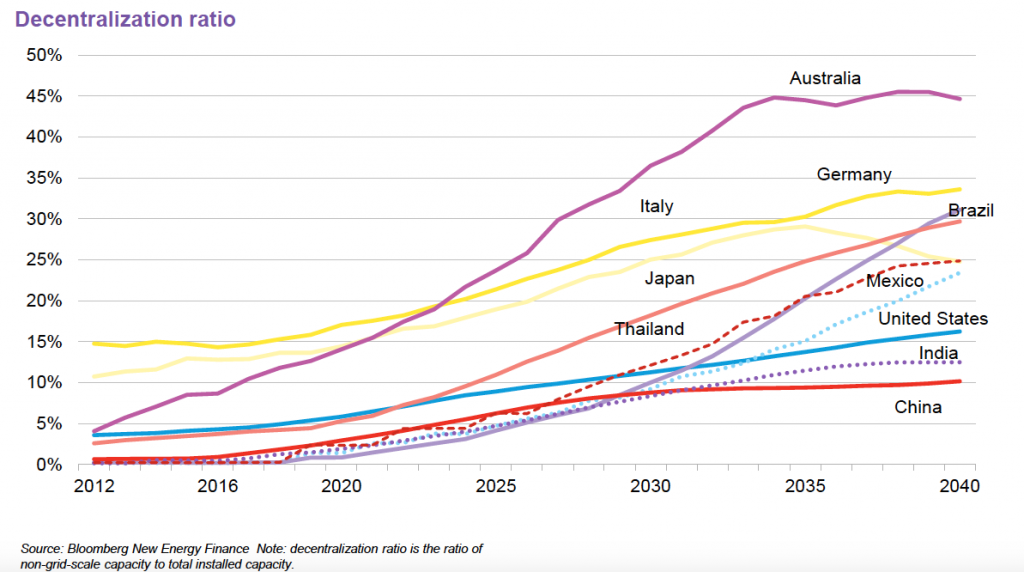The way people are interacting with their energy usage has taken a fundamental turn, making decentralised power a $50 billion business opportunity.
Solar panels, batteries and electric vehicles are becoming not only common household topics but common household assets. This has given birth to the ‘electrification of life’.
Energy meters not only provide real-time data so users can track consumption, but they also learn patterns and even optimise usage, transforming the average house into a smart, environmentally conscious home. Harnessing these technological developments, people are taking control of their energy usage and reducing reliance on a centralised energy provider.
This trend towards decentralisation of power (in both the physical and social sense) has the potential to disrupt the energy industry in Australia and in countries around the world.
Trend towards decentralised power
Decentralisation is a theme emerging in sectors across the economy. From Bitcoin to Airbnb and Uber, people are ‘sticking it to the man’. New technologies and business models are emerging to circumvent centralised control and dominant service providers.
This trend has spawned nimble and innovative enterprises, which are capturing the attention of customers and meeting the demand for more decentralised services.
Why is this exciting in the energy sector?
Australia is perfectly positioned to lead the world in the transition to a decentralised energy future.

We have the precise ingredients to bake a rich energy tech ecosystem. Our high electricity costs are driving people to take control of their electricity usage. As the lucky country, we are blessed with renewable energy resources, and the decreasing cost of distributed energy technologies are making an electrified life an attractive investment. Best of all, we have the cream of the crop in human capital, with high levels of education and an entrepreneurial spirit.
With these ingredients at hand and a lack of cooks in the kitchen, huge opportunities lie ahead on the road towards a sustainable energy system.
Australian start-ups like Greensync and PowerLedger are beginning to pave the way by developing technologies to facilitate peer-to-peer electricity trading and demand-side participation. More needs to be done for Australia to harness the entrepreneurial drive and create world leading IP to export to lagging energy markets.
Just as the PayPal Mafia knew scaling their businesses was dependent on the success of the broader start-up ecosystem in Silicon Valley, Australia needs to equip entrepreneurs and start-ups with the tools to bring their ideas to life.
What does this mean for you?
Along with one in 10 Australians, you can capture the Sun’s rays in your backyard and generate clean and reliable electricity. Just as you own a battery that powers your mobile phone, you can own a battery that powers lights in your house and the motor in your car. Just as you can rent out rooms in your house through Airbnb, you might soon be able to rent out your energy assets (ie a battery).
This means your quarterly electricity bill could include revenue as well as costs. With lithium-ion battery prices predicted to drop another 65-70 per cent by 2030, this dream could soon to be a reality.
Spark widespread benefits
Disruption will reach far beyond the household level. The opportunity to aggregate small consumers or provide demand-side participation (like reducing demand in peak periods) is in the hundreds if not billions of dollars. Coordinating all household appliances in Australia could create something in the range of a 7.5 GW demand response resource, 100 times the capacity of Tesla’s ‘big battery’ in South Australia.
Small, medium and large consumers will be able to lower costs, monetise excess energy and become empowered ‘prosumers’. Demand-side participation can even foster environmental sustainability by reducing net demand and providing flexibility to complement variable renewable energy generation.
It’s sunny! So we’re powering the house, feeding the Powerwalls *and* sending a little back to the grid. https://t.co/hA03cOOqwO pic.twitter.com/sr3obFHStI
— Phil Plait (@BadAstronomer) April 7, 2018
Reducing electricity bills, helping to lower emissions and supporting the integration of renewable energy – could decentralised power be the secret ingredient in balancing this energy trilemma?
The power balance is changing, opportunities are arising and a new path to decentralised power is ours for the making.
